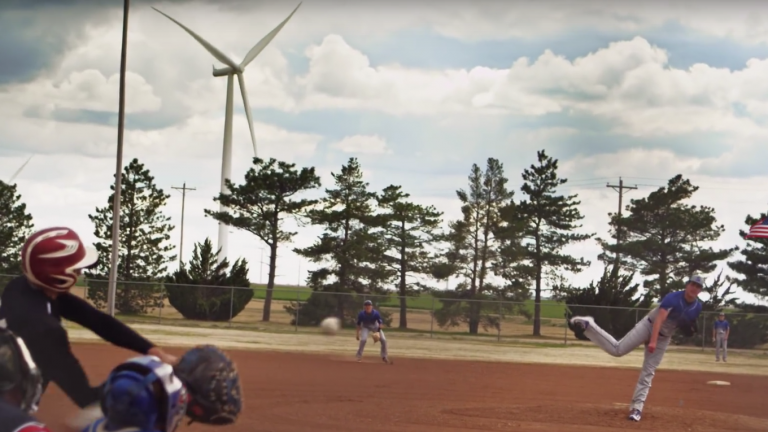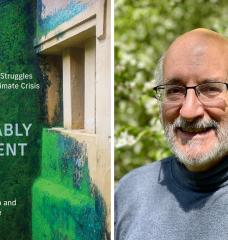
How can sustainability be incorporated into athletics?
MIT Climate sat down with MLB player Chris Dickerson. Dickerson has played for the Baltimore Orioles, Cincinnati Reds, Milwaukee Brewers, New York Yankees, and Cleveland Indians. In addition to his athletic accomplishments, Dickerson co-founded Players for the Planet with fellow baseball player Jack Cassel. Players for the Planet advocates for sustainability within both professional and recreational sports and allows athletes to utilize their following to combat climate change.
We discussed sustainability within baseball, American sports culture, and professional athletes utilizing their platform for social and environmental responsibility.
If you want to learn more about Chris’s environmental work, check out Players for the Planet and We Are One Village.
Mikaela: How did you first get involved in environmental activism?
Chris: Growing up in southern California, I was always a great observer of what was going on in our environment. From an educational standpoint, we’re taught the interconnectivity of our ecosystem. When I was younger, being around the resources I had, such as the beach, was a huge inspiration to me. Especially looking at the irresponsibility of people who left trash behind, and seeing how it affected ocean life.
Being an outdoor athlete and playing football, soccer, and baseball there were often times kids couldn’t show up to practice because the air quality was so poor. So that made me aware of the issue regarding transportation and the power that emissions have over in huge cities, and how that affects our health. So those were the two main ones for me; being an athlete and a beach-goer.
As I got older, my dad became a huge recycling advocate. He went to Home Depot and made a recycling module out of PVC pipe that would allow us to separate glass from plastic, and other designations. Seeing that early put me onto the fact that we have a responsibility to preserve and be responsible.
Mikaela: So what inspired you to start Players for the Planet?
Chris: I was sick over the holidays in 2007. I watched Al Gore’s An Inconvenient Truth, and that changed my perspective on the scope of the environmental issues we’re up against. Where we are not just at regionally, but on a global scale; and the dire situation that we put ourselves into. And looking back at it, we have made some progress. But ultimately, it’s alarming that in that 10-year stint, considering the speed of tech and innovation, we still haven’t made a ton of progress as far as the wide-scale implementation of these clean technologies around the world.
In 2008, I stumbled upon a Thomas Friedman article for Time magazine called “The Red, the White, the Green, and Why America Needs a Green Revolution.” And there was an advertisement in there for SIGG water bottles. It was a special global warming awareness co-op bottle they developed. It was a white aluminum bottle, and on the side of the bottle in big block letters it said: “I AM NOT PLASTIC”. This came at a time when I started to observe the amount of plastic that was used in the clubhouse. I was putting together the numbers, and trying to get a calculation or rough estimate about how much plastic we use in professional sports. It dawned on me that there must be some way to reduce our amount of plastic, given where my personal knowledge of where this ends up, and how it affects our communities and our environment.

I sent a press inquiry to SIGG and asked them to send us 50 water bottles for the locker room. I wanted to see how much I could cut down on our plastic use in the clubhouse. As you get higher up in these levels of baseball, the amenities become greater. So you have greater access to bottled water, Gatorade, bottled juice. But that means there’s also a lot more waste that’s generated within the clubhouse.
Trying to get guys away from using the reusable water bottles -- especially in the dugout where we’ll go through roughly 1,000 water bottles and plastic cups a day -- was important. Once people heard about what I was trying to do, ESPN.com and MLB.com wrote an article about my initiative. And it gained quite a bit of traction, especially amongst the Cincinnati Reds fans. Two months later, when I got called up, I played my first home game in Cincinnati. I had fan signs from people that had the recycling symbol on it. So that was the “aha!” moment; when I figured that there are people out there that demand answers, or are looking for answers on how we can be more responsible. For me, it was about how I can use my platform to benefit this cause. Even if it is just reducing plastic in professional sports, that is an area I can make a difference.
Mikaela: What role do you see athletes having in fighting climate change/climate justice in general?
Chris: It’s unfortunate in the aspect that (as you’ve seen in the last year and a half to two years) athletes’ political thoughts and reflections are often not welcomed by the general public. We’ve had that problem with the whole Colin Kaepernick thing, and that’s created a huge uproar about what the athlete’s role is in society. We’re told to ignore political dealings and to just focus on athletics, which is bogus obviously.
But that is amplified with the percentage of climate deniers. Climate change has been a very taboo subject in the past years. We are pointing to actions in which even if you’re a climate change denier -- the actions that you can change on a daily basis to improve the quality of our environment. Whether that’s carpooling, using solar power, reducing your water and power usage to recycling, or being more attentive to what you leave behind. We just tried to start with those.
A lot of people look up to athletes, so I found it was important to find guys for Players for the Planet I knew lived that type of eco-conscious life. They needed to have a concern for the environment, and want to use their platform to speak out, educate, and offer simple solutions to sports fans.
Mikaela: Sports are meaningful on an individual level, but occupy an important space in American culture. What are your thoughts on how we can make sporting facilities more sustainable, and how green practices can be incorporated into athletics?
Chris: That’s an obvious and great question because there are endless possibilities. We’re talking about huge companies, they generate hundreds and millions of dollars every year, and they have resources to go out and make an enormous drop in the bucket as far as environmental conservation and clean power.

There have been a few teams that have made the lead. The Boston Red Sox installed 1100 solar panels to power the TVs around the stadium. The Staples Center, the Seattle Mariners and SF Giants are regular recipients of the Green Glove presented by the MLB for highest diversion rate of waste from the landfill. The new Mercedes-Benz Stadium and Minnesota’s US Bank Stadium are both LEED certified Platinum stadiums. The focus is out there, and it is a movement. These investments in clean technology will help the bottom line and save these organizations millions of dollars.
As we’ve seen these LEED certified silver and platinum stadiums built, we now have a roadmap into professional sports defining what it means to be environmentally conscious when we’re building these massive stadiums. But more importantly what I think is missing is the educational component of it. There’s a lack of educating the fans on why they did it, what they can do themselves when they go home. They need to be developing public transportation incentives and setting up carpooling incentives to get people more involved. They are spending hundreds of millions of dollars in building these stadiums. But people need to know what they can do on a daily basis as well, and that is one thing that can be improved upon in the near future.
As these stadiums continue to be built, we have a huge opportunity moving forward. When these new stadiums are built, we educate, and we utilize the innovations of clean technology to move forward. In this particular space, especially considering the audience that we have, it is such a tremendous opportunity to inform the general public about environmental issues.
Mikaela: If you had a magic wand and could change one thing regarding the practices or politics that contribute to global warming, what would you change?
Chris: Off the top of my head, I would say that we put a tax on carbon. That itself is a compounding gesture because that tax is then compounded for funds into research on clean energy. Doing so with applying carbon tax will force the hand of certain companies and corporations to reduce their levels of carbon emissions. All the while we are taking great advantage of where we’re at technologically. That tax would be a great accelerator for the innovation of new technologies, that can accelerate our fight against climate change.
Solar isn’t exactly where we thought it would be 10 years ago. But the innovation in electric vehicles, batteries, and energy efficiency hold out the hope that we can have clean energy at a price and scale that billions can afford -- provided we put a price on carbon so these innovations can rapidly scale and move down the cost volume curve.
Mikaela: What are your future goals for Players for the Planet?
Chris: One of our future goals is a project called "We Are One Village." This is going to be a composition of athletes' and consumers' participation, consumer products, and emerging technologies, such as for clean air, solar energy, and medical care. We are making a social responsibility platform where we can utilize the players from Players for the Planet. In addition, we’ll feature retailers and companies that offer products that are sustainably built. The end goal is to increase the availability of resources for basic human needs, such as clean water, clean air, shelter, energy, education, and internet. With these different initiatives, our athletes will combine their on-field successes with a fan engagement process where we can support these different initiatives around the world.

On weareonvillage.org, if you buy a sweatshirt from a particular company, the proceeds go to building a house from sustainable materials in Haiti. You will be able to see the progress in real time, from your laptop, from your phone, and be able to share it through social media. People will see the benefits of your purchase, and get on board with the project.

As far as plans for Players for the Planet, our big move is developing a curriculum that can be shared with young sports fans and young athletes. One of the hopeful projects for PFTP is to build a fully sustainable Little League field. This can be comprised of Field Turf to reduce the need for water and upkeep, waterless urinals, solar power for lights and external structures, such as equipment rooms and press box, and structures built from sustainable materials. Additionally, we would love to implement the use of reusable water bottles that will be issued to every participating member of the league the can be filled with an in-wall refillable station that will be in the dugouts. Ultimately changing the culture by providing lessons through literature and start to cultivate a youth community that is understanding of the importance of zero-waste.
I had the opportunity to speak with Parley for the Oceans last week. What they’re doing -- their research on the plastic consumption and the irresponsibility around plastic use --- is a big thing for us. I’d love to work with them and build some content around people who are witnessing what is going on out there, and putting more eyes on the research and activism as far as the amount of plastic that’s being dumped in the ocean.
And for whatever reason, it’s one of those things we don’t hear much about. There are resources and players that have an interest in bringing this problem to light. As you know, the Great Garbage Patch in the Pacific Ocean is one of the great eyesores on this earth right now. Sadly, I’d say most people don’t know about it, and why it’s important that we practice environmental stewardship. These projects that can be brought to such a large audience through sports, and through these major organizations. Athletes should practice environmental stewardship and have a platform to share this information with their respective fans.






